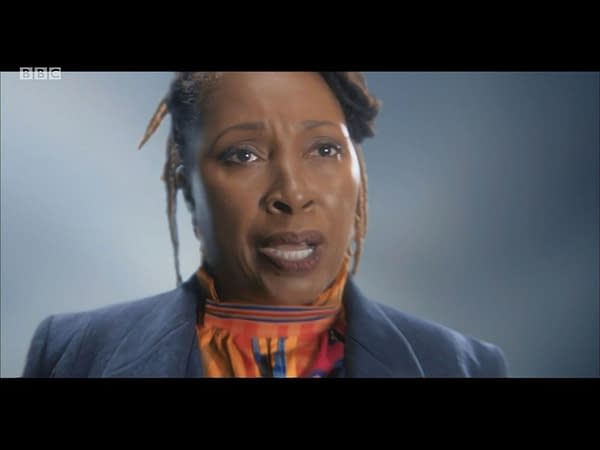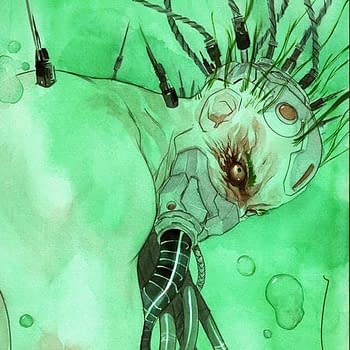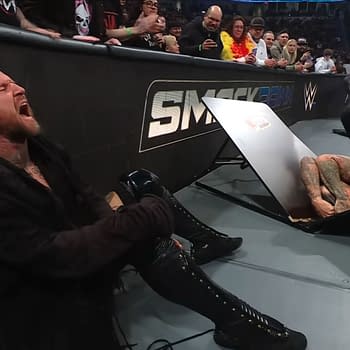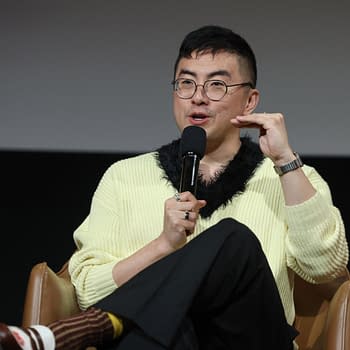That Meeting Of Absolute Batman And Absolute Wonder Woman (Spoilers)
Posted in: BBC, Doctor Who, TV | Tagged: Andrew Cartmel, bbc, cartmel masterplan, chibnall masterplan, chris chibnall, doctor who, finale, timeless children
The Cartmel Masterplan is Now the Chibnall Masterplan – 19 Questions (And Some Answers) From Doctor Who Finale
Okay, so yesterday's Doctor Who finale exploded quite a bit. Lots of people delighted, lots of people crying foul, and lots of people arguing about things that did or didn't happen. So what does that mean? A Bleeding Cool listicle, of course.
- Why did Missy talk about remembering the Doctor when she was a little girl? The Doctor was originally (as far as we know) a little girl, found by a portal to another universe by Tecteun, one of the ancestors of the Gallifreyans, then known as Shabogans. It is possible that Tecteun is also the mystery woman Time Lord that the Doctor nodded at in The End of Time. Turns out she was his mother after all – in a way.
- Where did the Time Lords come from? Taking her home, she was found to regenerate, that ability then gifted to the Shabogans, becoming Gallifreyans and Time Lords, and building the Gallifreyan society. It is comparable to the advances the West made on the East on Earth during the past two millennia, by way of not having as good pottery skills, so having to use glass instead, and creating spectacles which extended the working lifetimes of intellectuals and scientists. With regeneration, Gallifreyans extended their lifetimes to millennia.
- Why was the Master so angry that he burnt down Gallifrey? He discovered the truth, that all the Time Lords owe their genetic legacy to the Doctor, and the knowledge that she is a part of him was something he couldn't bear.
- Why did the Master think this knowledge would destroy the Doctor? It did him, once he discovered that Rassilon had been using him as a pawn for all these millennia, implanting the Time Lord heartbeat in his mind that drove him mad all these years, and was eventually just used to summon the High Council.
- Who were those orange faces in her flashback? Those were the faces of other pre-First Doctors as seen in The Brain of Morbius, intended to suggest previous lives of the Doctor, but then retconned away. And now retconned back. Man, we'll be getting The Valeyard next season, won't we?
- Where does The Fugitive Doctor fit in? We don't know. She could be one of the Doctor's pre-First Doctor versions of herself. But not necessarily. Probably more likely now.
- Where does The Fugitive Doctor's TARDIS fit in? Ah, there's the rub. If the Fugitive Doctor is a pre-First Doctor incarnation, then why does her TARDIS look like a police box? The TARDIS is meant to have assumed that form when the First Doctor first landed on Earth in a junkyard in Totter's Lane, London. Okay, so… fanwank theory. The TARDIS first assumed that form when it landed on Earth when the Fugitive Doctor hid herself – and the TARDIS – using the Chameleon Arch. And so she buried it for the longest time. When the mind-wiped First Doctor then arrived on Earth, the TARDIS found this familiar form to take – and has kept it ever since, not because the chameleon circuit is broken but because the TARDIS, in its own way, is trying to tell the Doctor who she really is. To try and trigger a memory, in a way that the Time Lords and the Division would never get. Chibnall, that's yours if you want it.
- Why does The Fugitive Doctor call herself The Doctor if she is pre-First Doctor who, as a child, named himself The Doctor? As with the TARDIS, the First Doctor called himself the Doctor as a child because he remembered somehow a previous version of himself calling herself that.
- Where does The Division fit in? A secretive black ops version of the Time Lords with a mission to interfere in the civilisations and timelines of others around the universe, in a way the rest of the Time Lords have forbidden themselves from doing. And presumably, the Time Lords who hired the Judoon to capture The Fugitive Doctor and have, right now, captured the Thirteenth Doctor (man these nominative choices are going to get harder and harder to justify now).
- And what about Ireland? The Doctor was one of The Division, but her mind has been wiped, with only the memory of foundling and immortal police officer Brendon of twentieth-century Ireland as an interpretation of what the Division actually did, courtesy of Tecteun.
- Who are the Timeless Children? The Doctor is, all of her. The Infinite Doctors.
- Doctor Who? Who is the Doctor? The essential mystery of the show that has been chipped away at over the last fifty-odd years, has been restored. Not a Time Lord. Not a Gallifreyan. Something else, from far beyond., and there are many more of her out there in the timestream…
- Is Chris Chibnall Redoing A Version of The Cartmel Masterplan? Chris Chibnall is an old school Doctor Who fan, and was prominent when Andrew Cartmel was the producer of Doctor Who, in the final days of the original series. It was to have been a new Doctor Who backstory developed primarily by Andrew Cartmel, Ben Aaronovitch and Marc Platt, by which they intended to restore some of the mystery of the Doctor's background that had been lost through revelation of the existing backstory. Although hints were dropped in the last two seasons, the proposed revelations never materialised onscreen as Doctor Who was cancelled. Stories such as Remembrance of the Daleks and Silver Nemesis were intended to suggest that he was more powerful and mysterious figure than previously thought. The Cartmel Masterplan was used as a guide for the subsequent Doctor Who: New Adventures novels licensed from the BBC and published by Virgin, and revelations about the Doctor's origins were written into the penultimate New Adventures novel, Lungbarrow by Platt. However, these origins were ignored and even contradicted by the new TV series from 2005 onwards. The Cartmel Masterplan would have added the Doctor as a figure to the founding of Gallifrey alongside Rassilon and Omega. Known as The Other, he was first mentioned explicitly in the novelisation of Remembrance of the Daleks by Ben Aaronovitch as a shadowy figure in Time Lord history, one of the founding Triumvirate of Time Lord society after the overthrow of the cult of the Pythia that had, until then, dominated Gallifrey. The Other was said to have powers surpassing that of Rassilon or Omega, and suggesting that he was not born on Gallifrey and a former version of the Doctor before he regenerated into The First Doctor. And now recreated as Doctor Who TV continuity, and planned for before he took over the showrunner gig. Let's call it the Chibnall Masterplan.
- Okay, so if the Time Lords and Gallifreyans inherited their ability to regenerate from the Doctor, how did River Song get her ability to regenerate? It was initially explained as having been conceived in the time vortex… but that's not it any more. So what is?
- Oh and what about the Doctor's Daughter? If the Doctor isn't a Time Lord, what about Jenny?
- What about Clara's journey? She travelled along the timeline of The Doctor visiting him at every point – why did she never go before the First Doctor?
- Why did the Doctor need the Time Lord's additional regenerations? Wouldn't they know that he didn't need them?
- While we are there, if the Doctor is not a Time Lord, how come she has two hearts like the Gallifreyans/Shabogans? Um… maybe the Shabogans got that from her as well? But then why did Pete's World Doctor just have one heart?
- Is this all too complicated for the kids? Not for my eleven-year-old, she explained it all to me last night, and was delighted when I showed her The Brain Of Morbius clip.
Any more for any more?
Stay up-to-date and support the site by following Bleeding Cool on Google News today!


















